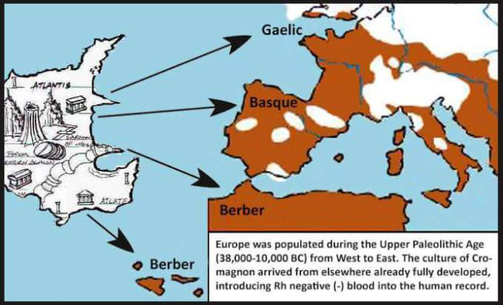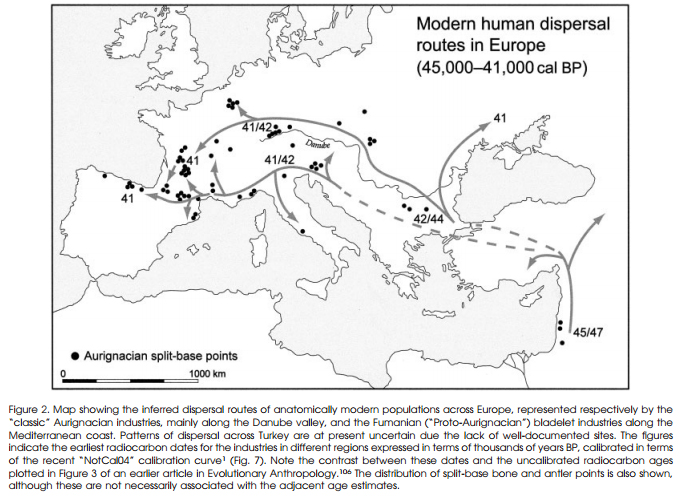|
The origins of the Aurignacian, a Paleolithic culture often associated with the appearance of modern humans in Europe, is key to Robert Sepehr's arguments in Species with Amnesia. Sepehr says that the Aurignacian culture “came from nowhere” and is associated with Cro-Magnon peoples migrating from west to east. Sepehr's claims about Aurignacian and Cro-Magnon are critical to his idea that modern humans did not originate in Africa but rather came from of a “lost world” known as Atlantis. His evidence is scarce and misconstrued. Sepehr claims that Aurignacian, dated about 43,000-26,000 years ago, simply “comes from nowhere.” Sepehr quotes Francois Bordes (page 37) stating “the Aurignacian tool tradition – without doubt—originates outside of Europe, ready-made, although from where is still a mystery.”  Sepehr's fantasy illustration showing Paleolithic Europe being populated form Atlantis. Sepehr's fantasy illustration showing Paleolithic Europe being populated form Atlantis. Sepehr challenges the idea that modern humans migrated into Europe from the east, stating “Cro-Magnon’s geographical distribution in Europe lies closer to the western part of Europe and North Africa, especially and probably most interestingly on a number of nearby Atlantic islands” (page 36). Also on page 44 Sepehr states that there were four stages of Cro-Magnon peoples appearing in northern Africa, including the Canary Islands, and fanning out from that western location. His ultimate claim is that the “evidence” of west to east movement supports the origin of modern humans in Atlantis. There are several problems with this. First, Aurigancian rather clearly moves into Europe from the east. This 2006 article by Paul Mellars (page 169) presents a map showing the spread of Aurignacian technology into Europe from east to west. Second, it is not clear that so-called Cro-Magnon peoples were the ones making Aurignacian tools. According to this article, Cro-Magnon
“doesn’t refer to a particular taxonomy or even a particular group located in a particular place. Cro-Magnon is a term that is commonly used to illustrate early modern humans who lived during the Upper Paleolithic Era. Simply, the word is not precise enough, and so most paleontologists prefer to use Anatomically Modern or Early Modern Humans.” While it is true that the Aurignacian tools are different from those of preceding periods and are usually thought to be the work of modern humans, there are very few skeletal remains associated with the Aurignacian. Mellars (page 177) explains that “Although finds of human skeletal remains in direct association with Aurignacian technologies are notoriously scarce in all parts of Europe, the available finds are entirely consistent with the conclusion that these industries were similarly associated with characteristically modern populations.” Mellars (page 177) notes that the “best association between Aurignacian industries and human remains are those of at least five individuals from the Mladeč caves in the Czech Republic.” Neanderthals would have been inhabiting Europe when human populations with Aurignacian technology came in. Since there are few human remains dating to this time period it is difficult to state for certain what truly happened when Neanderthals and modern humans interacted. As John Hoffecker writes “Because of the gaps and ambiguities of the human fossil record for this period, the transition from Neanderthals to modern humans in Europe has been reconstructed primarily on the basis of archaeological remains.” It is known that Neanderthals and modern humans lived in Europe during the same time for a number of years. It is logical to think that since Neanderthals had their own culture and own tools that Homo sapiens probably adopted some of the culture and tools which then they constructed to benefit them and their environment considering the latest Neanderthal remains have been found in western Europe, not eastern Europe. Additionally, I would like to point out that “archaeologists who specialize in the study of stone tools attribute particular types of tools, grouped into ‘industries’ or ‘cultures,’ with particular species of hominin.” This same article states that the stone stones found in France were called Aurignacian because the tools were found in Aurinac, France. How could modern humans have migrated from west to east, displacing or wiping out Neanderthals on the way, when the youngest Neanderthal remains are found in France? How can that logically happen? Wouldn’t that mean the youngest remains should be found in eastern Europe? Also, how can the Aurignacian tool industry “come from nowhere” when the archaeological site where these tools were found is in Aurinac, France? They look "new" in France because they came from outside of France, but from the east, not the west. Sepehr's claims that the modern human Paleolithic populations of Europe originated in Atlantis are not supported by evidence. Sepher quotes anthropologist Richard C. Leonard numerous times throughout the book and uses his “evidence and claims” to back up his argument on Cro-Magnon (e.g., on page 35). Sepehr also relies heavily on work from the early 1900's to support his claims. With science constantly evolving it is usually best to use research that is the most recent to show the newest findings. We know far more about humans and evolution now than we did back during the early 1900's. I would like to end this post with a quote by William R. Fix who wrote The Bone Peddlers: "The fossil record pertaining to man is still so sparsely known that those who insist on positive declarations can do nothing more than jump from one hazardous surmise to another and hope that the next dramatic discovery does not make them utter fools ..... Clearly, some people refuse to learn from this. As we have seen, there are numerous scientists and popularizers today who have the temerity to tell us that there is 'no doubt' how man originated. If only they had the evidence..." That is something to think about when reading his book.
0 Comments
Leave a Reply. |
AuthorWrite something about yourself. No need to be fancy, just an overview. ArchivesCategories |

 RSS Feed
RSS Feed
